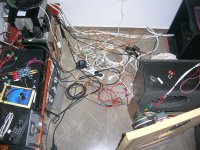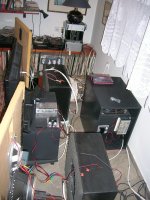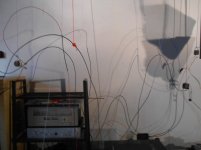You mean businessmen/salesmen will say almost anything and rip you off, wow, who would have thought?😉
Last edited:
She just cant stand to see 12 f***cables and a dozen of more coils&caps + another 12 f***cables, she says
😀
Attachments
I have found that 'born salesmen' once could make a lot of money in the audio business. They are usually 'semi-technical', not engineers, who have a large desire to make a go at a hi fi company. I have helped make both Mark Levinson and Noel Lee get successful, even rich, but in the end they both succeeded in cheating me one way or another to maximize their income. I have worked for others, as well, for the same purpose, but they were not as successful. Saul Marantz for example. In the end, his company would up owing me money that was never paid, and Saul would not do anything about it.
This sort of personality, is outgoing, friendly (when he wants to be), and semi technical. For example, Noel worked as a technician once, and Mark learned how to build quality circuitry with the help of others. They will flatter to get something, but in the end, they often cut you off without anything much. Still, I cannot deny them their success, I just wish they had shared it a little more with those who helped them get there.
I have mostly found that it depends upon how you approach the person. Most dont understand circuits and dont appreciate the value of a "simple" change which yields large improvement as worth anything. Nor will you get much with promises... even with a good reputation as circuit designer.
Pretty much you have to do a full design and prototype it and have them listen and if they like it, sign an Agreement.
THx-RNMarsh
Last edited:
Getting ripped off sucks indeed, am starting to be able and smell the personality from a greater distance than before.
Don't take it seriously. It was a joke 🙂Do you mean that, by decreasing the angle of the dangle, a cable lifter will reduce the vertical component of the cable force acting on the speaker terminals?
You are welcome John.Thanks Max for your input on this subject. I agree that it could be that synthetic materials in carpets rubbing against cables might make a difference. It could be triboelectric or dielectric differences between the wire covering and the carpet, make the difference.
I don't think rubbing or mechanical movement is involved, or not to any great extent, I think it is more to do with fields of different materials interacting.
We had a small party on Sat night, food, booze and music and everybody is expected to do a turn at being DJ (HD, Youtube, BT/phone), and I showed these friends that placing a piece of vinyl record on top of Gooped DAC pcb (chips and xtal) directly alters the sound.....consensus was that the vinyl screws up the sound compared to the un 'vinalysed' digital sound....diminished bottoms and highs, emphasis on mids with a overall AGC/Compressor/'loaded down' sound in comparison.
The vinalysed sound is not 'offensive' or 'bad' but the naked sound is clearer, livelier and more fun and readily apparent regardless of paused or OTF AB testing.
None of these friends are technical or 'audiophiles' but they do like their music and the vinyl changes were immediately obvious to these 'uneducated' listeners, go figure lol.
Later one friend commented that the system sounds 'efficient', and this is good observation, it does sound clear and 'unlimited' at any level (below overload of course, that said mild overdrive does not kill the sound, it just sounds a bit 'squashed' but still without harshness).
The more I explore and experiment with Goop the more I come to understand that materials (ie their fields) interact more strongly than is given credit for and the resultant audible modulations/intermodulations are according to their origins.
IOW these materials interactions cause amplitude and time dependent excess noises, ie excess noises control system signature according to materials mixed/alloyed/in contact/in proximity, and is normal and is to be expected.
I also find that this seemingly chaotic behaviour builds stage by stage (it's not purely chaotic/white so carries information) but can be stripped and a 'new order' installed or reinstalled at waypoints throughout the system as desired.
Excess noise production occurs strongly at transducers, so 'treatment' at system energy entry and energy exit (first power transformer and final speaker drivers) conductors and transducer body material (steel core assy and ferrite magnet assy) are the first points to target, this is why AC cables and speaker cable can have influence.
Capacitors are transducers also and capacitor behaviour is easily and readily alterable.
JB is causing a 'new order' by wideband dithering and damping of energy flow by way of mixture of oxide materials......the BQP is a short length of lossy coax in a sense and the field interactions between the internal resistor and the oxides resistive 'outer' acts as damped filter, albeit a deliberately noisy one......BQP does substantially 'amortise' or whiten energy flow and consequently reduce system excess noise BUT it does still leave an overall signature, this is what I object to with large BQP.
My approach is quite different and it seems it constitutes an 'escapement wheel' or sample and hold like timing control of energy flow.
By means of this 'timing control' at least some excess noise mechanisms don't get excited and manifest and harmonic and modulation/intermodulation distortions system signature essentially disappears and the system becomes essentially transparent/invisible.
The upshot of this is that the old school findings of tolerable distortion and noise numbers are valid, iow any modern economical amplifier/system can sound good, ie bloody good when the system is 'bounded' by energy flow controls and excess noise signature is not allowed to manifest and 'flare' as happens in so many systems.
The 'bounding' material mixture can be subjectively 'dead clean' and without signature or signature can be incorporated at will.
Consider a twin cable is a pair of conductors or conduits of energy bounded by typically some kind of polymer insulating/dielectric materials and usually with pigments and other materials such as flame retardants or UV incorporated.
The conductor emergent time varying magnetic and electric fields travel through/manifest outside these dielectrics and in these dielectrics some energy is stored and returned and some is converted to IR/heat as a 'loss'.
Energy absorption/return spectral and time dependent behaviours of materials constitutes signature, ie choose dielectrics and you choose signature, choose magnetic materials and you choose signature and so it goes, it's as simple as that.
Maybe somebody fully understands the depths of these energy field and matter interactions, in the meantime I find that this energy control concept applies to all manner of electronic, electric and electro-mechanical systems.
Dan.
You are welcome John.
I don't think rubbing or mechanical movement is involved, or not to any great extent, I think it is more to do with fields of different materials interacting.
I'm sure Mr. Marsh would agree this stuff is just what they did at LLNL but kept it hush hush.
Is that some kind of foam sandwich baffle?
The panels are sand-filled thin plywood. The foam strip is an aid for edge diffraction reduction.
(the intent was to show the usual mess)
George
Could you hear or measure a difference with/without the foam? Dependant on front/back symmetry there should be some cancellation of the diffraction (according to Geddes, makes sense)
George, you have succeeded admirably 🙂
The question is: at what price? What is the contrepartie, the quid pro quo, the pay off, or, otherwise said, no wife has ever existed that will put up with such an endulgence without handsome and ultimately lopsided compensation scheme.
The question is: at what price? What is the contrepartie, the quid pro quo, the pay off, or, otherwise said, no wife has ever existed that will put up with such an endulgence without handsome and ultimately lopsided compensation scheme.
@George: I only get away with it becuase the cables are hidden behind the piano 🙂
@Vacuphile: It can be done with the right woman and the right negotiation stance. I have had to build shelves to put the equipment on and all boxes have to be black, but otherwise I have freedom. It does help when SWMBO is a music lover as well!
@Vacuphile: It can be done with the right woman and the right negotiation stance. I have had to build shelves to put the equipment on and all boxes have to be black, but otherwise I have freedom. It does help when SWMBO is a music lover as well!
Last edited:
Real art!
I see the shadow (up firing omni?)
Now, please tell us about the science part (smile)
George
I see the shadow (up firing omni?)
Now, please tell us about the science part (smile)
George
I insist: That's science
The speakers are 3 way, each speaker suspended (>isolated) with rubber bands and the woofer box isolated, too, as well as each of the crossover components and cables.
Science consists in making the spring costant so that when 'hit', the component oscillates below 20 Hz, so out of working BW.
🙂
The speakers are 3 way, each speaker suspended (>isolated) with rubber bands and the woofer box isolated, too, as well as each of the crossover components and cables.
Science consists in making the spring costant so that when 'hit', the component oscillates below 20 Hz, so out of working BW.
🙂
- Status
- Not open for further replies.
- Home
- Member Areas
- The Lounge
- John Curl's Blowtorch preamplifier part III


